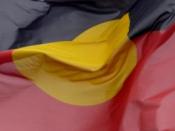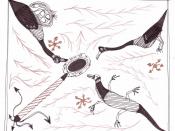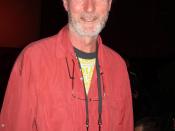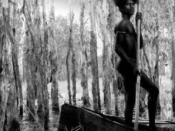By insisting ÃÂTen CanoesÃÂ (Rolf de Heer, 2006) have all its diegetic dialogue in the Aboriginal dialect of ganalbingu, writer and co ÃÂ director Rolf de Heer has made a subtle statement about indigenous pride and the situation of contemporary aborigines in Australia.
In ÃÂTen CanoesÃÂ (co ÃÂ directed by Peter Djigirr) the ÃÂmagpie goose peopleÃÂ of Arnhem Land are portrayed as empowered and in control of their language, their culture and their lives, rather than confronting the usual media presentation of Aboriginals as victims of colonial aggression, disrespect and maltreatment.
When discussing the seemingly perennial Aboriginal problems of substance abuse, domestic violence, unemployment and reduced life expectancy, the descriptor ÃÂdisadvantagedÃÂ is a term that immediately springs into mind, but de Heer reminds us that it should not be used as an automatic synonym for indigenes. Identifying and addressing the causes of the woe that blights the lives of many contemporary Aborigines remains important; nevertheless, one must not assume they have always been that way or will always be so.
White Australia has always been keen to limit Aboriginal culture to a mystically contained set of creation stories, whereas the narration in this film points us to Aboriginal culture as the basis for an ongoing social system with firm yet fragile sets of rules and obligations. These stylistic choices are also an object lesson in thinking out ways to overcome obstacles. In a relief from the actors and dialogue of too many Australian films, de Heer uses non ÃÂ actors.
ÃÂTen canoesÃÂ is the story of Dayindi, played by 17 year old Jamie Gulpilil, son of David Gulpilil, who also starred in de HeerÃÂs The Tracker (2002), and who provides the cheerful narration in this film. Dayindi coverts one of the wives of his older brother. To teach him the right way to do things, the crafty older brother (Peter Minygululu) tells his potential rival an instructive ancestral story, a tragic fable from the mythical past. It is a cautionary tale of doomed love, kidnapping, sorcery, bungling mayhem and ill directed revenge.
The starting point for the film was an old black and white photograph of canoe making taken by anthropologist Donald Thomson in the 1930ÃÂs, an artifact that has become part of the history of the Yolngu people of the Ramingining. The film was shot on their land, in and around the Arafura Swamp in north-eastern Arnhem Land in May and June 2005, amidst man-eating crocodiles, mosquitoes and leeches. With a relatively low budget of $2.2 million, it was funded by a syndicate consisting of the Australian Film Finance Corporation, the South Australian Film Corporation, SBS-Independent, Fandango Italy and the Adelaide Film Festival. The world premiere of Ten Canoes took place at the Adelaide Festival in 2006 on March 19 and the film was released nationally on June 29 through Palace Films. It was nominated for seven Australian Film Institute (AFI) awards, of which it won six, also wining numerous other awards.
An era of idyllic wellbeing preceded the white settlement of Australia, and, in black and white, de Heer takes us back to that time a thousand years ago ÃÂ and to an even earlier, more rapturous Dreamtime, which cameraman Ian Jones has lensed in vibrant colour.
Narration emerges as an alternative means of organizing time. In place of a linear historical time, the model of narrative in ÃÂTen CanoesÃÂ proposes a time that can be constantly revisited and reinhabited. The culminating moment in the frame story and the story within it comes with the repetition of a high-angle shot of men in canoes in what looks like a grassland, but is a swamp they are poling across. It is a moment in which time is recovered, when the local people from Ramingining recover the time of their ancestors and de Heer recovers the time of Donald Thomson.
The world of ÃÂTen Canoes is truly far, far away from most of us. The pixelly pleasure grounds of the multiplexes are probably closer to our imaginations now than the astonishing landscapes of North Australia, and the elaborate cosmological systems of the peoples who are among us yet whom we know so poorly. Suffice to say that the experience of watching ÃÂTen CanoesÃÂ is exactly the opposite of your social studies classes, though perhaps this film serves as a reminder for the naysayers that there is much of substance and worth in indigenous cultureÃÂ Have we found a new and creative way to bridge the cultural gap which still exists?Charles Chauvels film ÃÂUncivilisedÃÂ (1936) entangles racial politics at numerous levels. A white Australian women, Lynn sets out on an expedition to find a white savage, a white Australian man, Mara who lives with and rules an Aboriginal tribe. The racial politics within the film resolve around the representation of Aboriginal characters in comparison to the representation of white characters. Aboriginals within the film are shown as primitive and savage, and not represented individuality. They also possess no meaningful language and instead meaningfully grunt at one another. This refers to the aboriginals as being animal like. This film can be seen as representing the dominant ideology of 1930ÃÂs Australia that of white supremacy.
Rolf de Heers film ÃÂThe TrackerÃÂ (2002) tells the story of four men tracking an accused murder through the Australian outback. The film is set in 1922. The film confronts the changing power relationship between the men. The issues within the film are represented by the various characters. There is the Fanatic, the Veteran and the Follower. The Fanatic represents the extremists point of white supremacy. The Veteran represents the indifference towards aboriginals and their culture. By the end of the film the Follower is the only white character still alive. This can be read as representing de Heers view that the only way Australia can move forward is through acceptance and respect towards Aboriginal people and their culture.
Tracy MoffatÃÂs post modern film ÃÂNice Coloured GirlsÃÂ (1987) interweaves the story of three young Aboriginal women on a night out on the town. The gender politics within the film relate to how the Aboriginal women of colonial times and the 1980ÃÂs use their sexuality to gain economic benefits. The film can be read as portraying the unchanging nature of gender, sexual politics and relationships concerning aboriginal women and white men. Moffat is able to counter dominant representations of aboriginal women and their relationships with white men. These films visualise the interactions with white Australians from the early 20th to early 21st century.
Archie Roach, ÃÂThe Tracker (2002ÃÂ), Australian Screen. http://australianscreen.com.au/titles/tracker/. Accessed 8 August 2009, p.1.
Fandango Australia, ÃÂTen Canoes ÃÂ movie infoÃÂ. http://svc068.wic021v.server-web.com/tencanoes/info.htm. Accessed 28 July 2009, p.1-2.
Jamie Dayindi Gulpilil Dalaithngu, SBS films - Ten Canoes, http://www.sbs.com.au/films/movie/1907/Ten-Canoes. Accessed 2 August 2009, p.1.
Rolf de Heer and features the son of David Gulpilil in, 10 Canoes, http://www.vertigoproductions.com.au/information.php?film_id=11&display=synopsis. Accessed 3 August 2009, p.1.
Vertigoproductions.com.au, 10 Canoes. http://www.vertigoproductions.com.au/information.php?film_id=11&display=bio&id=7. Accessed 3 August 2009, p.1.
Imdb.com, Uncivilised (1936), http://www.imdb.com/title/tt0122298/plotsummary. Accessed 6 August 2009, p.1.
Allmovieportal.com, The Tracker (2002), http://www.allmovieportal.com/m/2002_The_Tracker.html. Accessed 6 August 2009, p.1.
Australian screen, Nice Coloured Girls (1987), http://australianscreen.com.au/titles/nice-coloured-girls/. Accessed 6 August 2009, p.1.
Belinda, Ten Canoes (Rolf de Heer), http://www.creativespirits.info/resources/movies/tencanoes.html. Accessed 20 August 2009.
David Walsh in the UK, a dramatic exploration of ancient Aboriginal culture, http://www.wsws.org/articles/2006/jul2006/sff2-j19.shtml. Accessed 15 August 2009.



